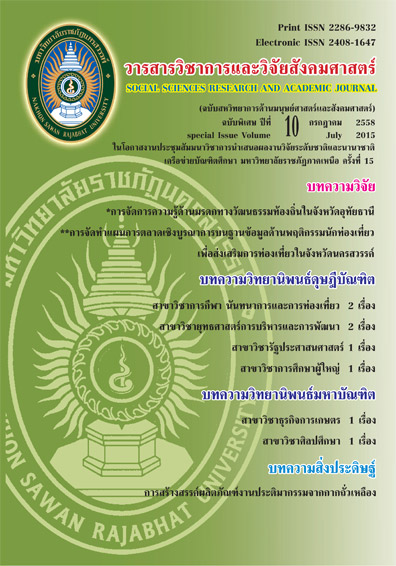การวางแผนชำระหนี้ของเกษตรกรรายย่อยด้วยบัญชีครัวเรือน กรณีศึกษาลูกค้าเกษตรกรธนาคารเพื่อการเกษตรและสหกรณ์การเกษตร สาขายางหล่อ อำเภอศรีบุญเรือง จังหวัดหนองบัวลำภู; Repayment Planning of Farmers Through Household Accounting: A Case Study: Farmers Customer
Main Article Content
Abstract
บทคัดย่อ
การศึกษาครั้งนี้มีวัตถุประสงค์เพื่อ 1) ศึกษาสภาพเศรษฐกิจและสังคมของลูกค้าเกษตรกร ธ.ก.ส. 2) เพื่อศึกษารูปแบบการจัดทำบัญชีครัวเรือนของลูกค้าเกษตรกร 3) เพื่อศึกษารูปแบบการวางแผนชำระหนี้ด้วยบัญชีครัวเรือนของลูกค้าเกษตรกร 4) เพื่อศึกษาปัญหาและอุปสรรคในการวางแผนทางการเงินด้วยบัญชีครัวเรือนของลูกค้าเกษตรกร ประชากรที่ใช้ในการศึกษาคือลูกค้าเกษตรกร ธ.ก.ส. สาขายางหล่อ อำเภอศรีบุญเรืองจังหวัดหนองบัวลำภู จำนวน 1,756 ครัวเรือน เลือกสุ่มตัวอย่างจำนวน 100 ตัวอย่าง โดยแยกเป็นลูกค้าที่ชำระหนี้ไม่ปกติด้วยการสุ่มแบบเจาะจง จำนวน 60 ตัวอย่าง และลูกค้าที่ชำระหนี้ปกติด้วยการสุ่มอย่างง่าย จำนวน 40 ตัวอย่าง เก็บข้อมูลโดยใช้แบบสอบถามทำการวิเคราะห์ข้อมูลโดยใช้สถิติคือ ค่าร้อยละและค่าเฉลี่ยเลขคณิต
ผลการศึกษาพบว่า ลูกค้าเกษตรกรส่วนใหญ่เป็นเพศชาย อายุเฉลี่ย 46.23 ปี โดยมีรายได้ภาคการเกษตรเฉลี่ยต่อครัวเรือน 288,780 บาทต่อปี และรายได้นอกภาคการเกษตรเฉลี่ยต่อครัวเรือน 68,340 บาทต่อปี มีรายจ่ายในภาคการเกษตรเฉลี่ยต่อครัวเรือน 119,379 บาทต่อปี และรายจ่ายนอกภาคการเกษตรเฉลี่ยต่อครัวเรือน 98,430 บาทต่อปี และมีหนี้สินกับ ธ.ก.ส. เฉลี่ย 131,100 บาทต่อครัวเรือน ลูกค้าเกษตรกรมีการจัดทำบัญชีครัวเรือน 3 รูปแบบ คือ รูปแบบที่ 1 การจัดทำบัญชีครัวเรือน 2-3 วันครั้ง ร้อยละ 58 รูปแบบที่ 2 คือ การจัดทำบัญชีครัวเรือนเป็นประจำทุกวัน ร้อยละ 19 และรูปแบบที่ 3 คือ จัดทำบัญชีครัวเรือนทุกสัปดาห์ ร้อยละ16 ส่วนการวางแผนชำระหนี้ของลูกค้าเกษตรกรมี 4 รูปแบบ คือ รูปแบบที่ 1 ลดค่าใช้จ่ายที่ไม่จำเป็นในครัวเรือน ร้อยละ 87 รูปแบบที่ 2 ออมเงินเพิ่มขึ้น ร้อยละ 74 รูปแบบที่ 3 ลดต้นทุนการผลิตทางการเกษตร ร้อยละ 69 รูปแบบที่ 4 กู้เงินจากแหล่งเงินทุนอื่น ร้อยละ 38 ด้านปัญหาอุปสรรคในการวางแผนทางการเงินด้วยบัญชีครัวเรือนของลูกค้าเกษตรกร คือ การทำบัญชีครัวเรือนทำให้เสียเวลาและมีความยุ่งยากและการไม่สามารถบันทึกรายการได้เนื่องจากการมีปัญหาในเรื่องการเขียนหนังสือ ดังนั้น ธ.ก.ส. ควรเข้าไปให้ความรู้และให้คำแนะนำเกี่ยวกับการจัดทำบัญชีครัวเรือนอย่างสม่ำเสมอเพื่อกระตุ้นให้ลูกค้าเกษตรกรจัดทำบัญชีครัวเรือนได้อย่างถูกต้องและต่อเนื่อง
Abstract
The purposes of this research were to 1) examine economic and social conditions of farmer customers of Bank for Agriculture and Agricultural Cooperatives, 2) investigate types of household accounting of farmer customers, 3) study types of debt repayment plan of farmer customers and 4) inspect problems and obstacles of financial planning with household accounting of farmer customers. The population of this research was 1,756 households who were the farmer customers of Bank for Agriculture and Agricultural Cooperatives, Yang lo Branch, Si bunrueang District, NongBualamphu Province. However, 100 samples of total population were randomized and divided into 2 groups. The first one consisted of 60 samples who were selected by using purposive sampling. The latter included 40 samples who were chosen by random sampling. The data were collected using questionnaires and then they were analyzed by some statistics such as percentage and mean.
The results found that most farmer customers were male and the average ages were 46.23 years. The average agricultural income was around 188,780 baht per household per year as well as nonfarm income was around 68,340 baht per household per year. The average agricultural expense was at 119,379 baht per household per year and nonfarm expense was at 98,430 baht per household per year. The average debt with Bank for Agriculture and Agricultural Cooperatives was 131,100 baht per household. Moreover, there were 3 types of household accounting provided by the farmer customers as follows. The first one or 58 percent was the household accounting updated every 2-3 days. The second one or 19 percent was the household accounting updated every day. The last one or 16 percent was the household accounting updated every week. Besides, there were 4 types of the debt repayment plan of the farmer customers. The first type or 87 percent was to reduce unnecessary household expense. The second type or 74 percent was to accumulate more savings. The third type or 69 percent was to decrease agricultural cost of production. The last type or 38 percent was to ask for a loan from other financial resources. Regarding the obstacles of debt repayment plan utilizing the household accounting, the farmer customers felt that it wasted their time and was complicated. Some of them were not able to record items due to their writing problems. Therefore, Bank for Agriculture and Agricultural Cooperatives should provide knowledge and suggestions to stimulate them to update the household accounting system correctly and constantly.


